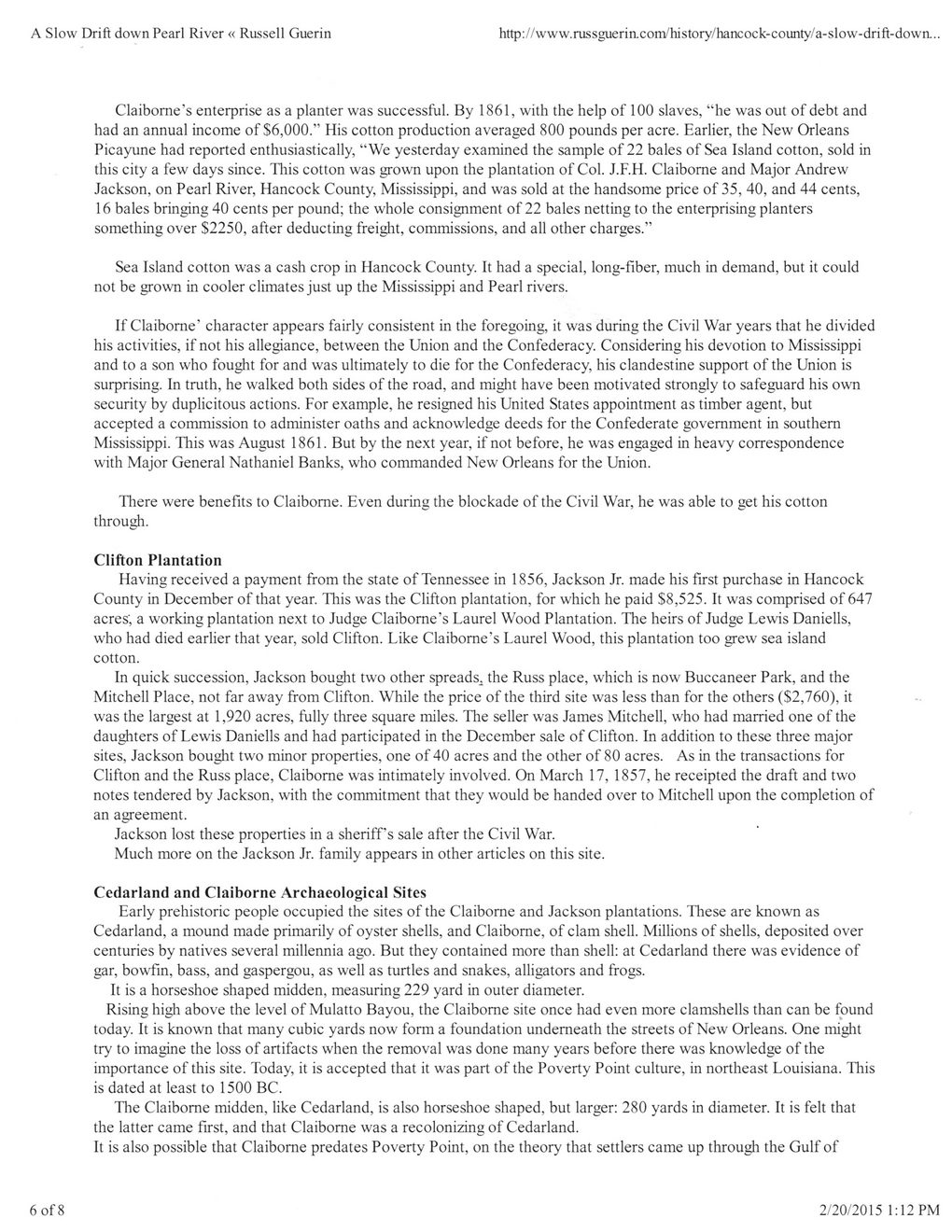This text was obtained via automated optical character recognition.
It has not been edited and may therefore contain several errors.
A Slow Drift down Pearl River « Russell Guerin http://www.russguerin.com/history/hancock-county/a-slow-drift-down. Claiborne’s enterprise as a planter was successful. By 1861, with the help of 100 slaves, “he was out of debt and had an annual income of $6,000.” His cotton production averaged 800 pounds per acre. Earlier, the New Orleans Picayune had reported enthusiastically, “We yesterday examined the sample of 22 bales of Sea Island cotton, sold in this city a few days since. This cotton was grown upon the plantation of Col. J.F.H. Claiborne and Major Andrew Jackson, on Pearl River, Hancock County, Mississippi, and was sold at the handsome price of 35, 40, and 44 cents, 16 bales bringing 40 cents per pound; the whole consignment of 22 bales netting to the enterprising planters something over $2250, after deducting freight, commissions, and all other charges.” Sea Island cotton was a cash crop in Hancock County. It had a special, long-fiber, much in demand, but it could not be grown in cooler climates just up the Mississippi and Pearl rivers. If Claiborne’ character appears fairly consistent in the foregoing, it was during the Civil War years that he divided his activities, if not his allegiance, between the Union and the Confederacy. Considering his devotion to Mississippi and to a son who fought for and was ultimately to die for the Confederacy, his clandestine support of the Union is surprising. In truth, he walked both sides of the road, and might have been motivated strongly to safeguard his own security by duplicitous actions. For example, he resigned his United States appointment as timber agent, but accepted a commission to administer oaths and acknowledge deeds for the Confederate government in southern Mississippi. This was August 1861. But by the next year, if not before, he was engaged in heavy correspondence with Major General Nathaniel Banks, who commanded New Orleans for the Union. There were benefits to Claiborne. Even during the blockade of the Civil War, he was able to get his cotton through. Clifton Plantation Having received a payment from the state of Tennessee in 1856, Jackson Jr. made his first purchase in Hancock County in December of that year. This was the Clifton plantation, for which he paid $8,525. It was comprised of 647 acres', a working plantation next to Judge Claiborne’s Laurel Wood Plantation. The heirs of Judge Lewis Daniells, who had died earlier that year, sold Clifton. Like Claiborne’s Laurel Wood, this plantation too grew sea island cotton. In quick succession, Jackson bought two other spreads^ the Russ place, which is now Buccaneer Park, and the Mitchell Place, not far away from Clifton. While the price of the third site was less than for the others ($2,760), it was the largest at 1,920 acres, fully three square miles. The seller was James Mitchell, who had married one of the daughters of Lewis Daniells and had participated in the December sale of Clifton. In addition to these three major sites, Jackson bought two minor properties, one of 40 acres and the other of 80 acres. As in the transactions for Clifton and the Russ place, Claiborne was intimately involved. On March 17, 1857, he receipted the draft and two notes tendered by Jackson, with the commitment that they would be handed over to Mitchell upon the completion of an agreement. Jackson lost these properties in a sheriff's sale after the Civil War. Much more on the Jackson Jr. family appears in other articles on this site. Cedarland and Claiborne Archaeological Sites Early prehistoric people occupied the sites of the Claiborne and Jackson plantations. These are known as Cedarland, a mound made primarily of oyster shells, and Claiborne, of clam shell. Millions of shells, deposited over centuries by natives several millennia ago. But they contained more than shell: at Cedarland there was evidence of gar, bowfin, bass, and gaspergou, as well as turtles and snakes, alligators and frogs. It is a horseshoe shaped midden, measuring 229 yard in outer diameter. Rising high above the level of Mulatto Bayou, the Claiborne site once had even more clamshells than can be found today. It is known that many cubic yards now form a foundation underneath the streets of New Orleans. One might try to imagine the loss of artifacts when the removal was done many years before there was knowledge of the importance of this site. Today, it is accepted that it was part of the Poverty Point culture, in northeast Louisiana. This is dated at least to 1500 BC. The Claiborne midden, like Cedarland, is also horseshoe shaped, but larger: 280 yards in diameter. It is felt that the latter came first, and that Claiborne was a recolonizing of Cedarland. It is also possible that Claiborne predates Poverty Point, on the theory that settlers came up through the Gulf of 6 of 8 2/20/2015 1:12 PM

Pearl River Document (006)